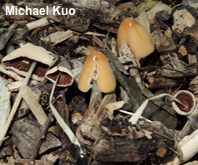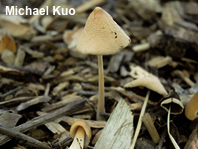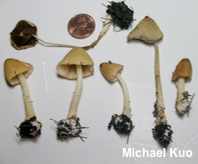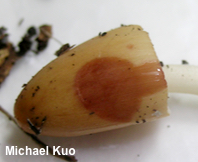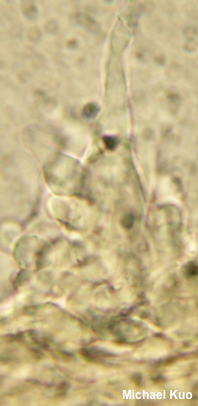| Major Groups > Gilled Mushrooms > Dark-Spored > Conocybe & Pholiotina > Conocybe hornana |

|
[ Basidiomycota > Agaricales > Bolbitiaceae > Conocybe . . . ] Conocybe hornana by Michael Kuo, 9 November 2023 Species of Conocybe are not usually very distinct, but Conocybe hornana is fairly easily separated from the Cono-masses with inspection of the stem base, which terminates in abrupt bulb that features a rimmed upper edge and, when fresh and young, a thin zone of white volval tissue; enlarge the third image to see what I'm talking about. Other characteristic macroscopic features include its fairly large size (for a Conocybe), and its orangish, sticky-when-fresh cap, which fades to yellowish buff. Microscopic features, if you need to go there, include cheilocystidia that are shaped like bowling pins, caulocystidia that aren't, and large spores with one end flattened for a large pore. Description: Ecology: Saprobic; growing alone or gregariously on soil or in yard waste or compost—or growing from straw or woodchips; found in urban areas and in woods; summer and fall; originally described from Austria (Singer & Hausknecht 1989); distribution uncertain (vouchered from the Netherlands, Norway, Québec, and Illinois). The illustrated and described collection is from Illinois. Cap: 1–2.5 cm; conic, becoming more broadly conic with age; tacky; bald; dull brownish orange to honey yellow-brown, fading to brownish or yellowish buff; the margin not lined. Gills: Narrowly attached to the stem; close; short-gills frequent; white becoming dull rusty brown. Stem: 3.5–7 cm long; 2–4 mm thick; equal above an abrupt, rimmed basal bulb that features a thin zone of volval tissue when young. Flesh: Insubstantial; whitish; unchanging when sliced. Odor: Not distinctive. Chemical Reactions: KOH on cap surface purplish pink. Spore Print: Reddish brown. Microscopic Features: Spores 12–15 x 7–9 µm; more or less ellipsoid, or slightly angular with 6 sides; flattened for a 1–1.5 µm pore; smooth; thick-walled; orange-brown in KOH. Basidia 22–25 x 10–12 µm; abruptly clavate; 4-sterigmate. Pleurocystidia not found. Cheilocystidia 20–30 x 5–10 µm; lecythiform, with a long neck and a globose head 2.5–3 µm wide; thin-walled; smooth; hyaline in KOH. Pileipellis hymeniform; terminal cells to 20 µm across; smooth; hyaline in KOH. Caulocystidia ranging from irregularly cylindric to more or less ellipsoid to lageniform or filiform, but never lecythiform; smooth; hyaline in KOH. REFERENCES: R. Singer & A. Hausknecht, 1989 (Watling & Hausknecht, 1997; Arnolds, 2005; Hausknecht & Krisai-Greilhuber, 2006; Tóth et al., 2013; Hausknecht & Vesterholt, 2018.) Herb. Kuo 06251701. This site contains no information about the edibility or toxicity of mushrooms. |
© MushroomExpert.Com |
|
Cite this page as: Kuo, M. (2023, November). Conocybe hornana. Retrieved from the MushroomExpert.Com Web site: http://www.mushroomexpert.com/conocybe_hornana.html |
